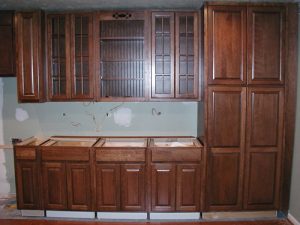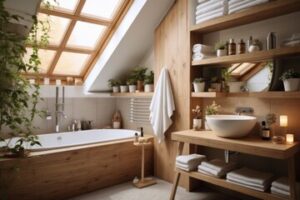San Jose Cabinet Refinishing is a cost-effective and quick way to modernize your cabinets. For best results, avoid using harsh chemicals or abrasives on your cabinets, as these can damage the finish and cause discoloration.

This method is less expensive and more environmentally friendly than replacing your existing cabinets. It also minimizes dust and mess, making it a safer option for the rest of your home.
Proper cabinet painting preparation ensures that your cabinets will receive a long-lasting, smooth finish. It is an important step that should not be skipped, as doing so may result in peeling paint or uneven surfaces. When properly completed, however, cabinet painting preparation results in a flawless makeover that you will love.
When preparing your cabinets for painting, the first step is to remove all hardware from your doors and drawers. This will allow you to work more efficiently and minimize any potential mess and damage. It is also a good idea to move any items that you want to keep out of the way to a different area of your home, such as a garage or a closet. This will prevent them from being affected by the painting process and prevent you from having to re-hang any pieces afterward.
After removing the hardware, you will need to clean the cabinets thoroughly with a degreaser and scuff sand any areas that are showing signs of wear. This will help the primer and later coats of paint to adhere correctly. It is also a good idea to purchase a special cabinet-grade primer, as it will be better able to withstand wear and tear than regular paint.
Next, you will need to sand the cabinet surfaces lightly to create a smooth, even surface. This will also help the new stain or paint to adhere properly. It is also a good idea to repair any scratches, dents, or blemishes at this point. Once the sanding is complete, you will need to apply a coat of primer to the cabinet surfaces. Let this dry completely before moving on to the staining or painting steps.
A cabinet refacing project is more extensive than a refinishing job, as it involves replacing the cabinet doors and drawer fronts while leaving the existing cabinet boxes intact. This is a great option if you are looking for a more drastic change in your kitchen’s look. However, if you are looking for a more cost-effective and less time-consuming solution, refinishing is the best choice.
Staining
Cabinet refinishing is a great option for homeowners who want to upgrade their kitchen without spending the money to buy and install new cabinets. The process involves stripping the old cabinet doors and drawer fronts, repairing any damage, and staining them to give them a fresh look. Refinishing can be done on wood or engineered wood products such as medium-density fiberboard (MDF).
First, the cabinet surfaces must be cleaned to remove dirt and grease buildup. Mix a solution of trisodium phosphate (TSP) or a similar deep cleaner with degreasing properties in warm water and dip a clean cloth into it, then wipe down the cabinet surfaces, paying particular attention to areas near handles and knobs where grease tends to collect. Allow the surface to dry completely before proceeding.
Next, the cabinets must be sanded to prepare them for staining. Using 220-grit sandpaper on a sanding block, sand all flat surfaces of the cabinet doors and drawer fronts, as well as any textured or molded areas. Make sure to sand with the grain of the wood. Then vacuum the area to remove any sanding dust. After sanding, the cabinets should be lightly wiped down with a damp rag to remove any remaining debris.
Once the cabinets have been wiped down, apply one or more coats of stain to achieve the desired color and finish. It is important to apply the stain in even, thin layers, and allow it to dry between coats. Depending on the type of wood used and your preference, you may need to apply additional coats of stain to darken the finish.
When the stain is completely dry, it is a good idea to apply a polyurethane top coat to seal in the stain and protect it from normal wear and tear. It is important to follow the product instructions carefully, as the stain will likely need several hours to fully cure.
Refinishing your cabinets can be a challenging DIY project, but with proper preparation and practice it is possible to achieve professional-quality results. If you are unsure about how to tackle the project, consider working with a professional cabinet refinishing company instead. Not only will they save you time, but they will also ensure a high-quality finish that will last for years to come.
Painting
Cabinet painting is a great way to refresh your kitchen’s look and can even increase your home’s value. However, there are many steps involved in the process that must be taken carefully to ensure that your paint job looks good and lasts. A quality cabinet paint job requires proper surface preparation and a high-quality product. Without the right skills and knowledge, you may find yourself dealing with chipping or peeling paint in a short period of time.
A good starting point is to clean your cabinets with a degreaser such as TSP or another degreasing agent. This will help to remove any grease or grime that has built up on the surfaces of your cabinets, and can make a huge difference in the outcome of your cabinet painting project. After cleaning, it’s important to scuff sand the surfaces of your cabinets before priming. This will help to remove any sheen and prepare the surface for a smooth finish. After sanding, it’s important to wipe down the cabinets with a damp cloth to remove any dust and dirt from the surface.
Once the primer is applied, it’s a good idea to wait for it to dry completely before moving on to the actual painting. This will help to prevent any bleeding or flaking. Once the primer has dried, it’s a good idea to sand the cabinet surface again and wipe down any areas that are chipping or uneven. This will create a smooth surface for your paint and help to ensure that your paint adheres well.
After the cabinets are painted, it’s a good idea to allow them to dry completely before installing any hardware. This will help to prevent any damage or chips during the installation process. Finally, it’s a good idea to label your cabinet doors and drawer fronts before beginning the refinishing process. This will make it easier for you to return them to the correct place when the refinishing is complete.
Refinishing can be done as a DIY project, but it’s not an easy task and is best left to professionals who have the expertise to ensure a professional-looking result that will stand up to years of holiday feasts, family chaos, and weekday stress. If you’re considering updating your cabinets, contact us to see how we can transform your space.
Cleaning
Whether your cabinets are painted or stained, it’s important to regularly clean them. Over time, dust and grease accumulates on cabinet surfaces and can cause long-term damage if not removed properly. In addition, dirt and grime can clog scrubbing pads or scratch the finish of painted cabinets. Regular cleaning helps prevent these problems, making your cabinets look like new for years to come.
Avoid the Mistake of Using Harsh Cleaners
In an effort to remove stubborn stains or food residue, some homeowners may use too much pressure when scrubbing their cabinets. Aggressive scrubbing can damage the surface, leaving worn spots and scratches that can be difficult (if not impossible) to repair. Using a soft sponge and a mild dish soap diluted with water is usually sufficient for routine cleaning. For tougher stains, a paste made of baking soda and water can help break down grease without damaging the stain.
Some homeowners rely on wax- or silicone-based products to add shine and protect their cabinets. These products can actually cause long-term damage to your cabinets by attracting dust, allowing moisture to seep in, and creating an unsightly buildup on the cabinet’s surface. If you have been using these products, it’s important to remove them before starting your cabinet refinishing project.
Many homeowners also make the mistake of overusing caulking on their cabinets, which can leave a sticky residue and lead to mold or mildew growth. Caulking should be used sparingly and wiped down regularly with a damp cloth.
If you have white cabinets, it’s also a good idea to use a solution of one part white vinegar and two parts water to wipe down the surfaces. Vinegar is a natural cleaner and can help prevent the formation of mildew or mold.
